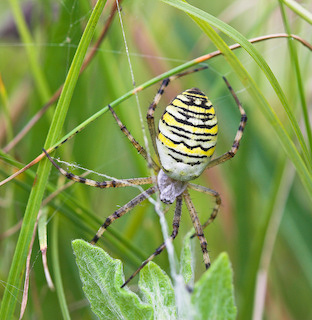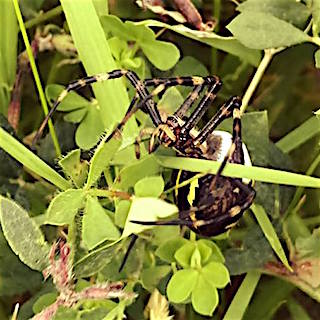Scientific name: Argiope bruennichi
What to look for:
· Family: Araneidae.
· Colouring and appearance: Female: yellow and black horizontal to zigzag stripes on abdomen. Males: pale brown.
· Size: Length: females 18 mm, males 5 mm.
· Where: Southern England, in long, rough grassland.
· When: April to October.
 Grasshoppers beware! They are the main food of the instantly recognisable Wasp Spider. With its yellow and black markings on the abdomen, it is easy to see how this distinctive spider got its name. It is however the female that is the showy one of this species: males are much smaller, and a pale brown in colour.
Grasshoppers beware! They are the main food of the instantly recognisable Wasp Spider. With its yellow and black markings on the abdomen, it is easy to see how this distinctive spider got its name. It is however the female that is the showy one of this species: males are much smaller, and a pale brown in colour.
Like the more commonly known Garden Spider (Araneus diadematus), the Wasp Spider weaves orb webs low to the ground to capture its prey. It is, however, far less common in smaller gardens. This is because of its prey preference, but also because it is a creature of rough, uncut grassland.
 A Wasp Spider takes about one hour to spin its web, usually at either dusk or dawn. In common with some other species of orb-web spider, the web includes a ‘decoration’ (stabilimentum). In the case of this species, the stabilimentum takes the form of a white zig-zag stripe running down the middle of the web. No-one is really sure of the function of this structure, and it is the subject of much debate.
A Wasp Spider takes about one hour to spin its web, usually at either dusk or dawn. In common with some other species of orb-web spider, the web includes a ‘decoration’ (stabilimentum). In the case of this species, the stabilimentum takes the form of a white zig-zag stripe running down the middle of the web. No-one is really sure of the function of this structure, and it is the subject of much debate.
Did you know…?
…The first recording of a Wasp Spider in Britain was from Rye, East Sussex, in 1922. It is frequently found across southern England.
…The much smaller male is only active for a couple of weeks in July. He lurks at the edge of a female’s web until she is mature, then mates as soon as possible, while her jaws are still soft, in the hope of avoiding being eaten. Sometimes this self-preservation strategy works, often it doesn’t…
Published: September 2016
Author: Amanda Scott
Photos: Homepage and lower this page: Rebecca Hughes; upper this page: © Natural England/Allan Drewitt
